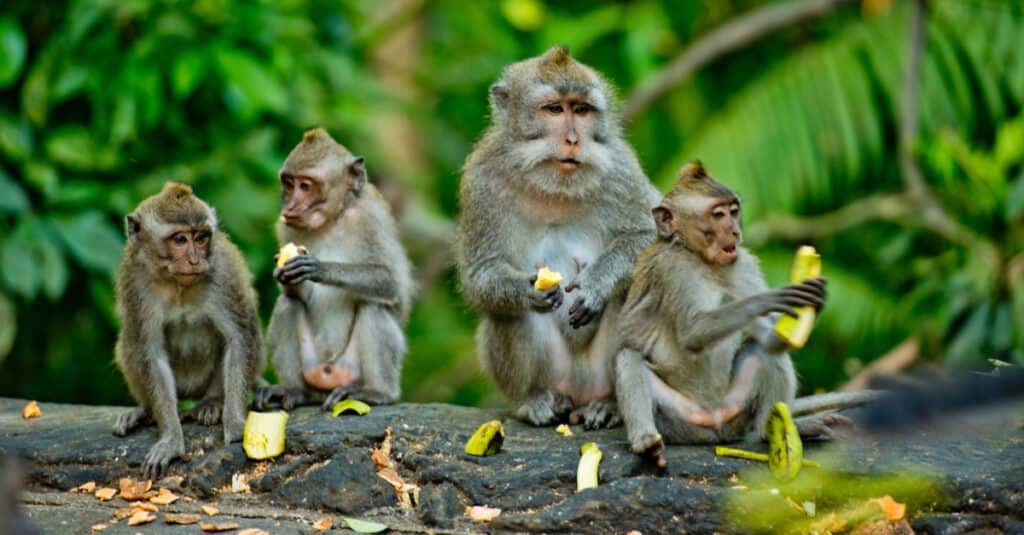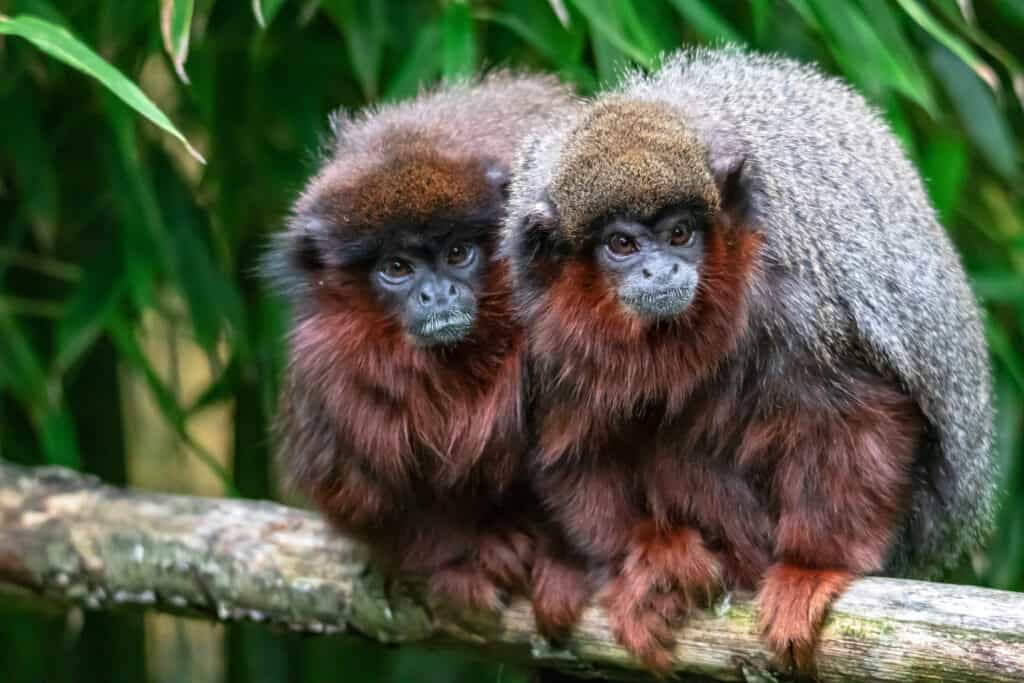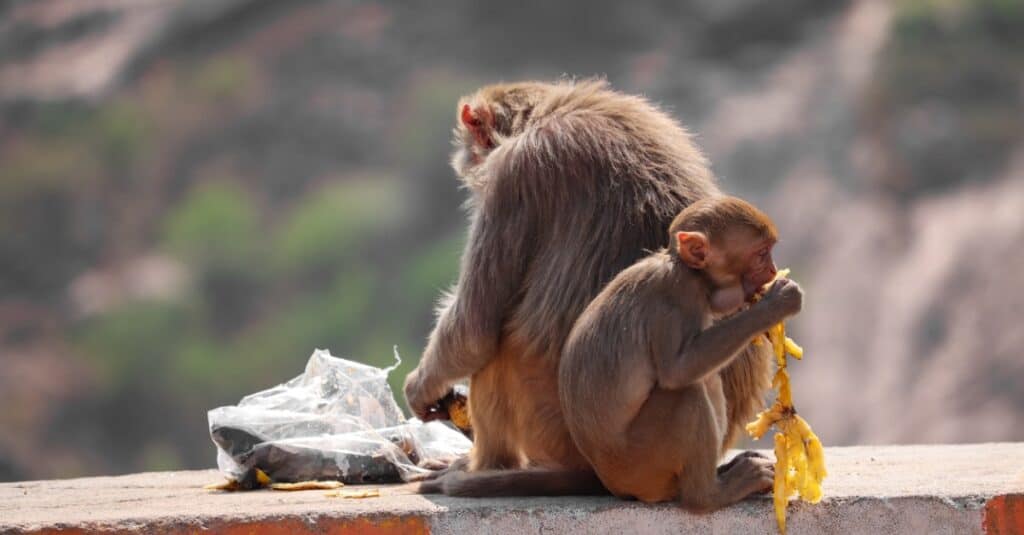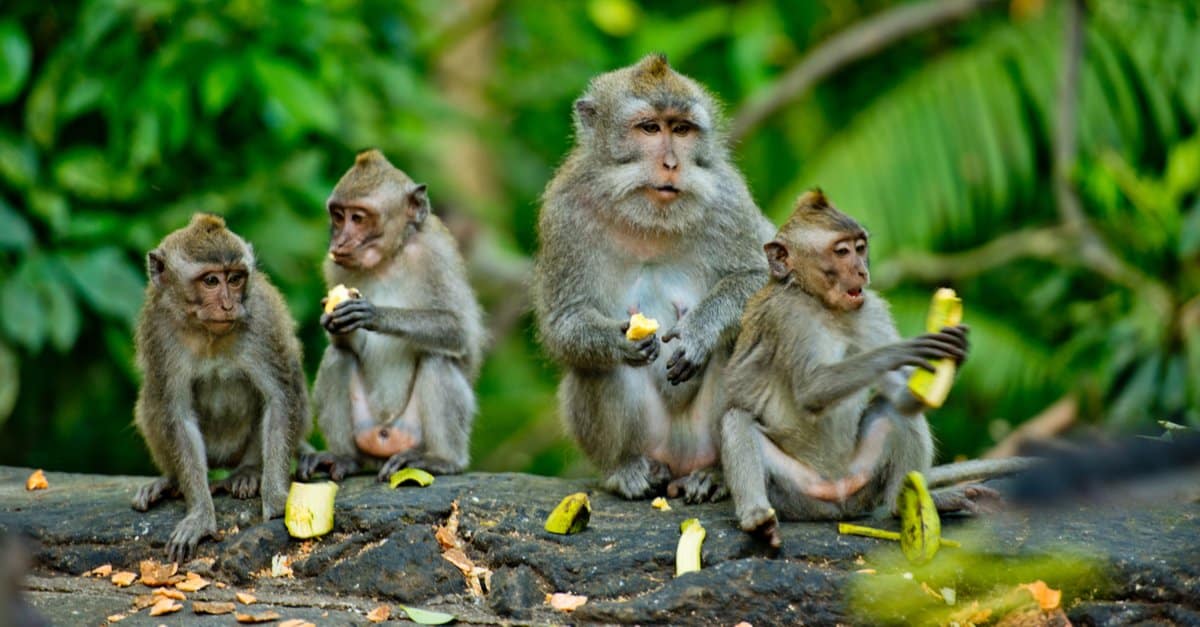Monkeys are extremely intelligent animals and are one of the closest relatives to humans. Because of this, monkeys show intelligent behavior, with many of them similar to people. Some monkey behaviors result from observing people, whether in captivity or proximity. Some of these shared behaviors come naturally to monkeys, but let’s learn about the group of monkeys, what they are called, and how they behave.
What Do You Call A Group Of Monkeys?

Monkey groups are called troops, tribes, barrels, or cartloads, and their behaviors mimic people to a large degree.
©Leo_nik/Shutterstock.com
A group of monkeys has a range of names: tribe, troop, barrel, etc. But the group is commonly known as a troop. Other primates like lemurs are known as a conspiracy.
The Behavior Of Monkeys
Like humans, monkeys individually form relationships with other monkeys in their troops and area. Monkeys are extremely intelligent and will base their relationship with other monkeys on experiences with specific monkeys. For example, suppose a monkey has had a bad experience with another monkey and crosses paths. In that case, they will often show aggression and rage. This conduct can lead to the fighting and the death of one of the monkeys in some cases. But contrarily, when a monkey comes into contact with a monkey they have had a good experience with, they will show respect and affection. An example of care and attachment is grooming. When monkeys have good relationships with others, they will regularly join fights to defend and protect their friends.
Monkey Groups and Mourning

Some monkeys mourn in ways similar to humans.
©iStock.com/guy-ozenne
Some monkeys mourn in ways similar to humans. For example, when a troop leader dies, the monkeys will often gather around the body and sit in silence. In some cases, the rivals and enemies of the dead monkey will also gather and sometimes even touch the monkey, showing their sadness and respect. Female monkeys who lose their infants also show sorrow and will carry the infant’s corpse for days or months as a sign that she is not yet ready to let the tragedy go. This behavior indicates that monkeys may not understand and process death like people but definitely experience emotions and difficulty processing the end of those they love.
Groups of Monkeys and Stress
People aren’t the only creatures that experience stress. Many animals experience anxiety and display behavior projecting this as people do. Monkeys also often undergo social anxiety. An example of this is the anxiety of male baboons in troops. When male baboons in a troop try to climb the social ladder, they can sometimes suffer high blood pressure and ulcers. Male baboon leaders also undergo stress when they fight off rivals and younger males trying to take their position on the social ladder. Male baboon leaders will frequently show signs of depression.
Infant Monkeys and Motherly Monkey Behavior

Female monkeys’ care and love for their infants shape their emotional state and development.
©iStock.com/Akash Kaparaveni
Female monkeys’ care and love for their infants shape their emotional state and development. In some species, like rhesus and pigtail monkeys, infants display certain behaviors when their mothers are absent. The infants will coo and desperately search for their mothers if they are alone too long. Eventually, the infant will stop searching and take on a slouched posture. This reaction is similar to the behavior of human infants when they long for their mothers.
Baby monkeys that have not had much love and affection from their mothers and other troop members during their early stages of development also experience adverse, long-lasting effects. For example, one study discovered that adult rhesus monkeys’ lack of love and affection towards their offspring in the first year of life affected them adversely. The neglected baby monkeys demonstrated more rage and aggression towards stranger monkeys than their counterparts who received adequate love and affection in their formative years.
Groups of Monkeys and Fairness

A troop works together to care for the young monkeys.
©Leo_nik/Shutterstock.com
Monkeys are not as advanced as humans and do not share the same values as we do. But scientists have found that they understand fairness as we do to some extent. For instance, monkeys share food if they feel their peers do not have enough to eat. Still, this sharing depends on the situation and their relationship with the other monkey.
When primates like marmosets and tamarins live in family troops, they are fairer and share food freely amongst their family members. But monkeys that do not often live in family troops, like capuchin monkeys, will freely share food if they have a good relationship with a specific monkey. Besides food, some species of monkeys display behavior that benefits others in their troop and surroundings. One case is vervet monkeys that shout alarm calls to warn others if predators are nearby. Baboons also form alliances to support others if they have to fight for territory, survival, or other reasons.
Groups of Monkeys and Saying No
Shaking your head in disagreement is typical behavior among humans. Still, some monkeys share this behavior. Zookeepers know that some monkey species, like chimpanzees and bonobos, will shake their head, inferring “no” or “don’t do that” to their young. For example, bonobo mothers shake their heads while trying to stop their young from climbing dangerous objects. These monkeys also shake their heads if their young play with their food instead of eating it. It is unclear whether this conduct is natural or if primates have learned it by observing people. Still, any group of monkeys definitely understands the meaning of shaking their head, meaning “no.”
Thank you for reading! Have some feedback for us? Contact the AZ Animals editorial team.








